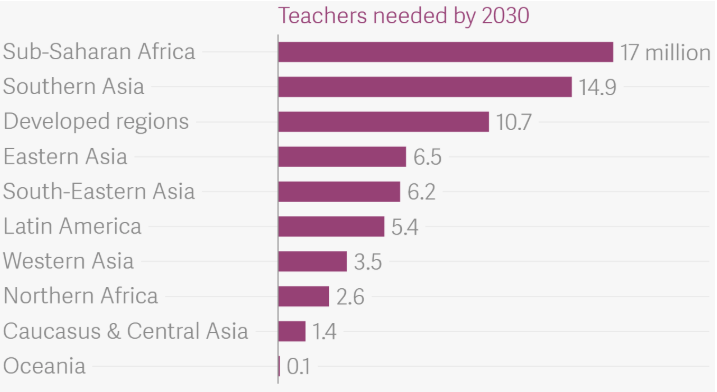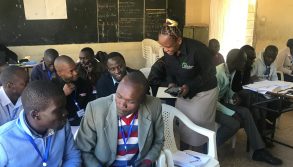How can teachers be supported?
16 October 2019
We all remember our favourite teacher at school, the ones who ignited our interest in a particular subject and inspired us to pursue lifelong learning. Many of these teachers would have received significant levels of support from their school and its staff to feel the confidence necessary to light that spark in a child.
Unfortunately, pupils having a supportive and inspiring teacher is not guaranteed. Many children in low and middle-income countries don’t have effective role models to inspire a lifelong journey of learning. If teachers in school are not provided with even the minimum of support required to succeed, then we will have no chance of achieving the desired outcomes of Sustainable Development Goal 4 (SDG 4): quality learning for all.
Today, there are just under 400 million children of primary or lower-secondary age who go to school but don’t learn. This is on top of the 264 million children who don’t go to school at all. It’s estimated that by 2030, we’ll need an additional 69 million teachers to replace those that are retiring or leaving the profession (sometimes through lack of support!) and to handle the increase in enrolment necessary to fulfil SDG4. Supporting teachers is an absolute priority, and fundamental to effective classroom management and desirable learning outcomes.
A recent report from the Education Commission highlights the size of the challenge. In seven African countries, 23% of all teachers were not present in school. In addition to this, of the teachers that were in school, 45% were not in the classroom. Under half are in the classroom teaching. Obviously, in this scenario, learning simply cannot happen. For some parents, the opportunity cost of sending a child to school to learn nothing is too high and they’ll just remove them from school completely—contributing to the hundreds of millions who don’t attend formal education.
Teachers must be empowered to teach
What is absolutely vital is that current and prospective teachers must believe in—and participate in—the education system. To put it simply, they must feel supported and empowered to teach.
As well as absent teachers, Sub-Saharan Africa also has a severe shortage of teachers. In fact, the region is furthest away from achieving SDG4 out of every region in the world. Less teachers = too many pupils per class = learning can be compromised for those lucky to be in school, with a teacher. Research from the UNESCO Institute for Statistics has found that 17 million teachers are needed by 2030 to achieve sustainable development in the region, with Southern Asia needing 14.9 million teachers.

According to the Global Teachers Institute, many young Africans aren’t joining the teaching profession due to a lack of prestige to join the profession; others don’t turn up to school because there’s no support once they start teaching.
How teachers can be supported
The education sector must explore reforms that will make teaching an attractive profession. The Education Commission has suggested a few ways that this can be done:
- Reimagining the education workforce. Before any progress can be made, we must acknowledge that there is a teaching crisis. While teachers are at the heart of the classroom and the learning process, it must be known by everybody in education that teachers can’t work alone. They require leadership, guidance and support; only then can we begin to see progress amongst pupils.
- Visions for the education workforce. A specific and feasible plan must be in place to proceed with reforms that deliver the necessary support. This includes implementing immediate incremental change through strengthening the existing workforce, a shift away from individualism and towards a team-based education system and a fundamental change through transforming an education system into a learning system.
- Navigating the political economy of workforce reforms. It’s vital for reformists to analyse and explore examples of previous strategies that have been used to address economic challenges that come with implementing education reforms. This way, we can learn from successes and failures from previous attempts so that similar errors don’t occur.
What Bridge are doing to support teachers
Ever since Bridge was founded in Kenya in 2007, appropriate levels of support and guidance for all teachers have always been a priority. We’ve always acknowledged that there’s a crisis in the classroom. We’re working towards being part of the solution, as are others. Our approach is based on data, and knowledge of what works. Evidence—not ideology—will be a key tool in navigating the political economy of workforce reforms; with consequences for those who aren’t teaching, whilst rewarding those who do. Making accountability about contribution and reward not blame, will no doubt make the profession much more appealing.
Ongoing training, support and development is a good way to keep teachers in the profession, with an emphasis on their learning as well as the child. We provide initial training for government and community teachers so that they become effectively up-skilled in teaching a classroom, as well as holding frequent ‘refresher’ courses to help teachers to learn effective techniques. Learn more about why effective teacher training is so important, here.
The teachers we support receive regular feedback through having school leaders observe lessons to ensure that teachers are effectively teaching the lesson content and engaging with their pupils. This feedback allows teachers to know exactly what their strengths and weaknesses are, and how they can improve going forward. Teacher Madhavi Pilli explains below how regular feedback and coaching has helped her to grow as a teacher and deliver lessons effectively.
We must always ensure that teachers across the globe have the right amount of support in order to succeed. Often the answer is not about more money, it’s about using existing funds more effectively and putting in place frameworks and structures that will help new and existing teachers alike benefit from more training, and more support. Inspire a teacher, and you’ll inspire a child. Inspire a child, and you can change the world!









